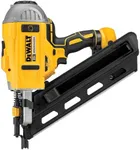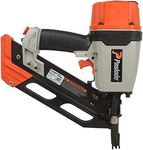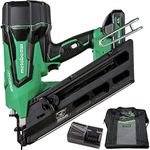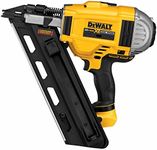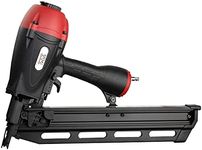Buying Guide for the Best Cordless Framing Nailers
Choosing a cordless framing nailer can make your construction or DIY projects much easier and more efficient. These tools are designed to drive nails into wood and other materials without the need for a compressor or hose, giving you more freedom to move around. When picking the right cordless framing nailer, it's important to understand the key features and how they relate to your specific needs, such as the type of projects you plan to tackle, how often you'll use the tool, and your comfort with handling power tools.Power Source (Battery Type and Voltage)The power source of a cordless framing nailer is usually a rechargeable battery, and the voltage indicates how powerful the tool is. Higher voltage batteries (like 18V or 20V) generally provide more power and longer run times, which is useful for heavy-duty or frequent use. Lower voltage models are lighter and may be easier to handle for smaller projects or occasional use. Consider the size and frequency of your projects: if you plan to use the nailer for large framing jobs, a higher voltage is better, while lighter tasks can be handled by lower voltage models.
Nail Size and Magazine CapacityNail size refers to the length and thickness of nails the tool can handle, while magazine capacity is how many nails the tool can hold at once. Larger nail sizes are needed for heavy framing, while smaller nails are suitable for lighter construction. A larger magazine means fewer stops to reload, which is helpful for big projects. Think about the types of materials you'll be working with and how often you want to reload; choose a nailer that matches your typical nail size needs and offers a magazine capacity that keeps your workflow smooth.
Weight and ErgonomicsThe weight and design of the nailer affect how comfortable it is to use, especially for long periods. Heavier models can be tiring to hold, but may offer more power, while lighter models are easier to maneuver but might not be as robust. Ergonomic features like comfortable grips and balanced weight distribution can reduce fatigue. If you expect to use the nailer for extended periods or in awkward positions, prioritize a lighter, well-balanced tool with good ergonomics.
Firing Modes (Sequential vs. Bump Fire)Firing modes determine how the nailer shoots nails. Sequential mode requires you to press the nose against the work surface and then pull the trigger for each nail, which is safer and more precise. Bump fire mode allows you to hold the trigger and 'bump' the nose to fire nails rapidly, which is faster but requires more control. If you value speed for large projects, bump fire is useful, but for precision and safety, sequential mode is better. Some nailers offer both, so consider your comfort and the type of work you'll do.
Depth AdjustmentDepth adjustment lets you control how deep the nail is driven into the material. This is important for different types of wood and project requirements, as you may need nails flush with the surface or slightly countersunk. Tools with easy, tool-free depth adjustment make it simple to switch settings on the fly. If you work with a variety of materials or need flexibility, look for a nailer with convenient depth adjustment.
Jam Clearing MechanismNail jams can happen, and a good jam clearing mechanism makes it easy to remove stuck nails and get back to work quickly. Some nailers have tool-free jam release features, while others may require extra steps. If you want to minimize downtime and frustration, especially on bigger jobs, choose a model with a simple and accessible jam clearing system.



